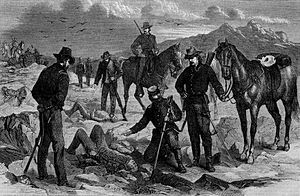Modoc War
| Modoc War | |||||||
|---|---|---|---|---|---|---|---|
 Engraving of soldiers recovering the bodies of the slain May 3, 1873 |
|||||||
|
|||||||
| Belligerents | |||||||
| Modoc | United States | ||||||
| Commanders and leaders | |||||||
|
Kintpuash Scarface Charley Shaknasty Jim |
Frank Wheaton John Green Reuben Benard Alvan Gillem Edwin Cooley Mason Jefferson C. Davis Edward Canby † Donald McKay Billy Chinook |
||||||
| Strength | |||||||
| 120 warriors | 1,000 infantry, scouts and cavalry 2 howitzers |
||||||
| Casualties and losses | |||||||
| 17 warriors killed 39 warriors captured |
73 soldiers and volunteers killed 46 wounded |
||||||
|
|
The Modoc War, or Modoc Campaign (also known as the Lava Beds War), was an armed conflict between the Native American Modoc people and the United States Army in northeastern California and southeastern Oregon from 1872 to 1873.Eadweard Muybridge photographed the early part of the US Army's campaign.
Kintpuash—Captain Jack led 52 warriors in a band of more than 150 Modoc people who left the Klamath Reservation. Occupying defensive positions throughout the lava beds south of Tule Lake (in present-day Lava Beds National Monument), those few warriors resisted for months the more numerous United States Army forces sent against them, which were reinforced with artillery. In April 1873 at a peace commission meeting, Captain Jack and others killed General Edward Canby and Rev. Eleazer Thomas, and wounded two others, mistakenly believing this would encourage the Americans to leave. The Modoc fled back to the lava beds. After U.S. forces were reinforced, they finally achieved the surrender of some Modoc warriors, and Captain Jack and the last of his band were finally captured. Jack and five warriors were tried for the murders of the two peace commissioners. Jack and three warriors were executed and two others sentenced to life in prison.
The remaining 153 Modoc of the band were sent to Indian Territory (pre-statehood Oklahoma), where they were held as prisoners of war until 1909, settled on reservation land with the Shawnee. Some at that point were allowed to return to the Klamath Reservation in Oregon. Most Modoc (and their descendants) stayed in what became the state of Oklahoma. They achieved separate federal recognition and were granted some land in Oklahoma. There are two federally recognized Modoc tribes: in Oregon and Oklahoma.
The first known explorers from the United States to go through the Modoc country were John Charles Fremont together with Kit Carson and Billy Chinook in 1843. On the night of May 9, 1846, Frémont received a message brought to him by Lieutenant Archibald Gillespie, from President James Polk about the possibility of war with Mexico. Reviewing the messages, Frémont neglected the customary measure of posting a watchman for the camp. Carson was concerned but "apprehended no danger". Later that night Carson was awakened by the sound of a thump. Jumping up, he saw his friend and fellow trapper Basil Lajeunesse sprawled in blood. He sounded an alarm and immediately the camp realized they were under attack by Native Americans, estimated to be several dozen in number. By the time the assailants were beaten off, two other members of Frémont's group were dead. The one dead attacker was judged to be a Klamath Lake native. Frémont's group fell into "an angry gloom."
...
Wikipedia
